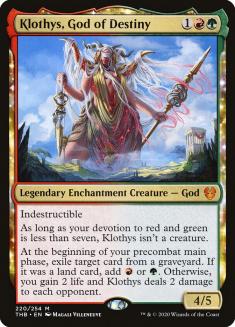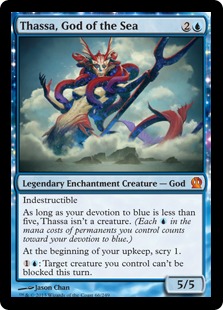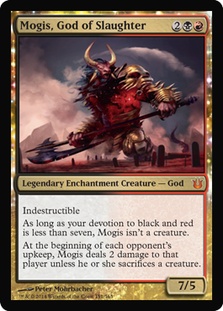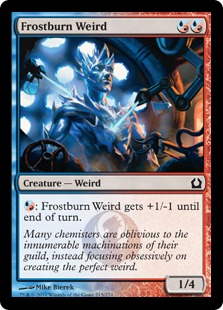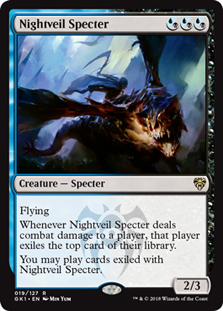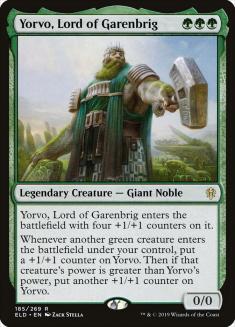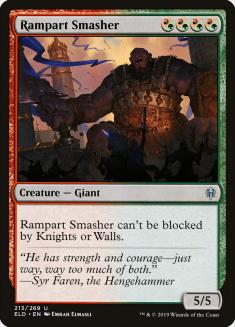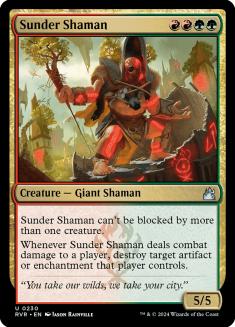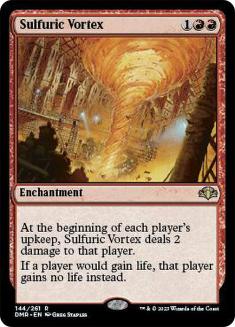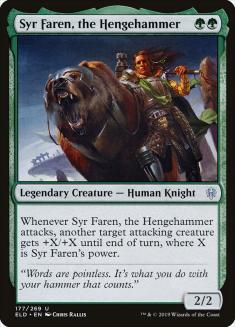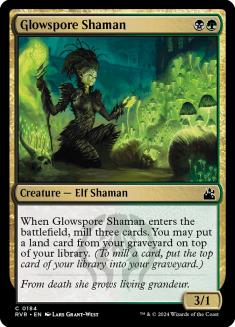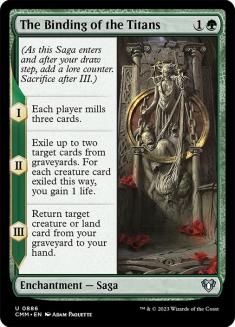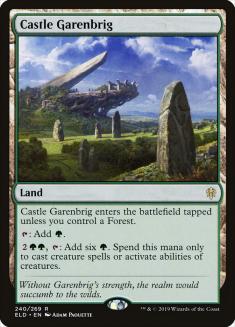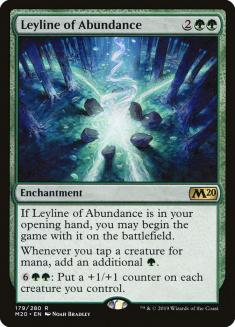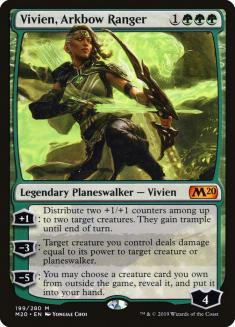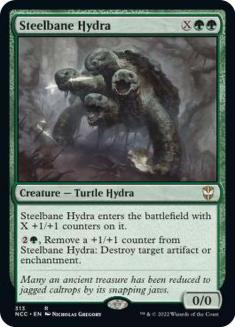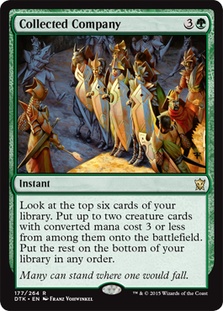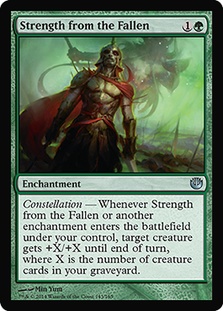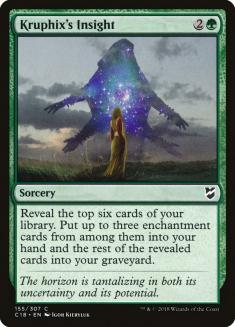How good is a God? What if it costs three mana and has depth to the noncreature ability?
The Theros Gods ranged from terrible to format-defining, and they were some of the trickier cards even without a weird ability to build around. Klothys, God of Destiny certainly points towards being on the more playable side of this range, so it’s time to start early on finding the best home for the card.
The Math of Devotion
Devotion-based Gods are a repeated mechanic from the original Theros block, and those old trends aren’t obviously favorable for Klothys, God of Destiny. Of the original monocolored Theros Gods, almost all of them saw Constructed play, headlined by Thassa, God of the Sea. Of the Born of the Gods and Journey to Nyx multicolored Gods, barely any saw play.
Why was this true, and what is different this time besides Mutavault not being in Standard?
The monocolored Gods having multiple abilities is part of it, but the multicolored Gods get a full-page spread of text for their ability. Klothys’s ability gains life, deals damage, makes mana, and exiles cards in graveyards. Is that really less than two marginal abilities of value?
Math is the reason. Monocolored Gods took five total devotion to get battle-ready, while multicolored Gods took seven. If you subtract out their own mana costs, that’s four additional devotion to make Thassa, God of the Sea into a creature, whereas it takes five more to do the same for Klothys, God of Destiny.
The only way to get five total devotion in two other permanents is if one of them has three or four symbols of the right colors, whereas you can simply cast two double-costed cards for your Thassa to attack. The original Theros Standard was really light on these three-devotion options at lower costs, with just Boros Reckoner and Nightveil Specter as remotely reasonable options. But it was full of ways to get two devotion from a card, so it often took a full extra permanent to attack with your multicolored God.
That devotion limit just isn’t true in Theros Beyond Death Standard. A lot of casting cost barriers have been broken down recently. Throne of Eldraine has the cycle of triple-costed Nobles, the quad-cost hybrid cards, and Ravnica Allegiance has the double-double four-drops. I’m not saying all of these cards are Standard-playable for every color combination, but there are options this time around. There are even some weirdo cards like Living Twister or Feather, the Redeemed that hit full multicolored devotion at asymmetrical costs.
The Throne of Eldraine cards point in a specific direction for multicolored Gods. You want to play base one color and splash the other using almost entirely lands that produce your main color. That means for Klothys, God of Destiny there are two primary approaches: green and red.
Red-Based Klothys
Creatures (27)
- 4 Ember Hauler
- 4 Gruul Spellbreaker
- 2 Skarrgan Hellkite
- 4 Zhur-Taa Goblin
- 2 Living Twister
- 4 Bonecrusher Giant
- 3 Torbran, Thane of Red Fell
- 1 Rampart Smasher
- 3 Klothys, God of Destiny
Planeswalkers (4)
Lands (25)
Spells (4)
Sideboard

The red cards currently available are just a pile. If there was something that just had more stats at the Ember Hauler devotion rate I might have better things to say, but right now this is just the same as every Big Red deck ever: some expensive cards, some removal, and the hope you draw your cards in ascending mana cost order.
While this is mostly high rarities and good rates, there are some synergies worth exploring. Sarkhan the Masterless plus Torbran, Thane of Red Fell is a cute combo, as is Fabled Passage letting Klothys, God of Destiny jump you into the good five-drops. Torbran also survives a Chandra, Awakened Inferno sweep, since it only amplifies damage to opposing creatures, but doesn’t boost the emblems since they aren’t red. Note that while Klothys does deal damage with the trigger and Torbran does amplify that, that combo involves untapping with both on the battlefield and your opponent not already being at negative fifteen life.
I don’t think the above deck quite does Klothys, God of Destiny justice. The damage ability is slow since it doesn’t trigger for a full turn cycle, but the Big Red deck basically can’t trigger it. That makes Klothys a three-mana sometimes 4/5 with a sometimes upside, and that’s not significantly better than the other three-cost options around.
I think the optimal red-based Klothys deck has more ability to utilize the God as a Sulfuric Vortex. Skewer the Critics and Slaying Fire are a good start, but without an actual Lightning Strike you run out of options quickly. With a couple more sets of burn spells, I can see Klothys playing the role of longer-game “engine” that threatens more than three or four damage from a single card, but the pieces aren’t quite there yet.
Green-Based Klothys
I don’t think that raw green aggro is quite where Klothys is the best. It has all the issues of the red cards, where Klothys is a conditional 4/5 with an ability you can’t set up well.
That means we have to try some stuff to get full leverage from our Klothys, God of Destiny in green decks.
Creatures (24)
- 4 Glowspore Shaman
- 4 Gilded Goose
- 3 Korvold, Fae-Cursed King
- 3 Feasting Troll King
- 4 Cauldron Familiar
- 3 Deathless Knight
- 3 Klothys, God of Destiny
Lands (24)
Spells (12)

This deck is definitely “trying some stuff.” You may also call that “Ari loves Feasting Troll King a bit too much,” but it does costs quadruple green and Klothys enjoys some graveyard filling. Having multiple quad-green cards that recur from your graveyard is a great way to keep Klothys active, especially since Klothys’s trigger gains life to recur Deathless Knight.
My big lesson about Feasting Troll King in early Throne of Eldraine brews was that the raw graveyard reanimation play wasn’t supported well enough by the Food cards available, but a splash of self-mill and extra Food in a deck readily able to cast the card was great. You would much prefer actual Satyr Wayfinder to either of these cards as Witch’s Oven fuel and sticky devotion, but at least The Binding of the Titans triggers Korvold, Fae-Cursed King when the Saga completes. I almost want to include The Akroan War for similar reasons since it plays so well with your many sacrifice effects and is interaction you can find with Trail of Crumbs. There’s also certainly some unknown card with the escape mechanic waiting to be previewed that will make its way into this shell.
Earlier versions of this deck I was tossing around included Castle Garenbrig, but I realized that once you wanted some graveyard support and Witch’s Oven for Feasting Troll King, you rapidly start spiraling down the full Jund Sacrifice road.
But that doesn’t mean there isn’t a Castle Garenbrig deck in the format. I left out one other devotion enabler we didn’t have last time. Leyline of Abundance was banned in Pioneer for being a devotion enabler, so we have to at least try it in Standard. Even if it doesn’t generate bonus mana from a Klothys trigger, your cards still all point in the same ramp direction.
Creatures (23)
- 4 Hydroid Krasis
- 4 Incubation Druid
- 4 Paradise Druid
- 4 Voracious Hydra
- 4 Gilded Goose
- 3 Klothys, God of Destiny
Planeswalkers (5)
Lands (24)
Spells (8)
Sideboard

Most of this deck shouldn’t be shocking. These are the good ramp cards we have been playing for half a year. It just happens that the Klothys-Leyline package slides right on in if you play The Binding of the Titans as another way to find action and fuel Klothys. Leyline of Abundance also boosts Nissa, Who Shakes the World lands, so your Hydras are comically large when you fully go off.
Vivien, Arkbow Ranger is a card I’m torn on in this deck. It plays very well with Incubation Druid when you have a Hydra to ramp into, adds a bunch of devotion for Klothys, and fits well into a few curves like Gilded Goose plus Leyline of Abundance or just two-drop into four mana. But it isn’t a real ramp payoff that takes over a game. One or two seems fine, but I’m much closer to wanting zero than three.
I generally oppose dedicating sideboard space to Vivien, Arkbow Ranger, but Steelbane Hydra just makes sense. It’s a Thrashing Brontodon that scales, and with constellation returning in Theros Beyond Death there might actually be a deck where a dedicated stream of Naturalizes absolutely wrecks them. Add another one to the Brawl deck Standard playables tally; good luck ever finding this card on short notice if you need it for a tournament.
Klothys in Pioneer
Somehow, all the Pioneer decks I want to build with Klothys feel like they are missing a card even more than the Standard decks are.
The first thing that jumps out to me about Klothys, God of Destiny in older formats is that you can find it off Collected Company. Sam Black recently played a land-centric Collected Company deck featuring Ramunap Excavator and Wayward Swordtooth, and a version of that deck with Satyr Wayfinder showed up in Magic Online League results. Shifting from Sam’s blue splash to a red one isn’t a big deal,
The natural issue here is that Collected Company forces you to play all creatures and very few cards that naturally go to the graveyard, and the mana in Pioneer does not inspire me to splash Glowspore Shaman. If a green or red Satyr Wayfinder redundancy exists in Collected Company range I haven’t found it, but I wouldn’t be shocked to see one on the way before Golgari cards rotate out of Standard.
The other idea is centered around a pet card from Theros Block Constructed: Strength from the Fallen. In this case, your backup Satyr Wayfinders are readily available in Kruphix’s Insight, Commune with the Gods, and now The Binding of the Titans.
The problem is finding the right mix and density of enchantments and creatures. You need to play dual-type enchantment creatures to make this happen, and you start scraping the bottom of the barrel with the current offerings. Klothys, God of Destiny is a step in the right direction as a backup graveyard payoff, but you start looking at Nyxborn Rollicker and Mogis’s Warhound really quickly once you go past that.
In this case, we are directly waiting on the remaining cards in Theros Beyond Death for the answer. It’s hard to say exactly how powerful a card leaning on multiple set mechanics will be without that full context, but Klothys, God of Destiny is at least off to a good start.

